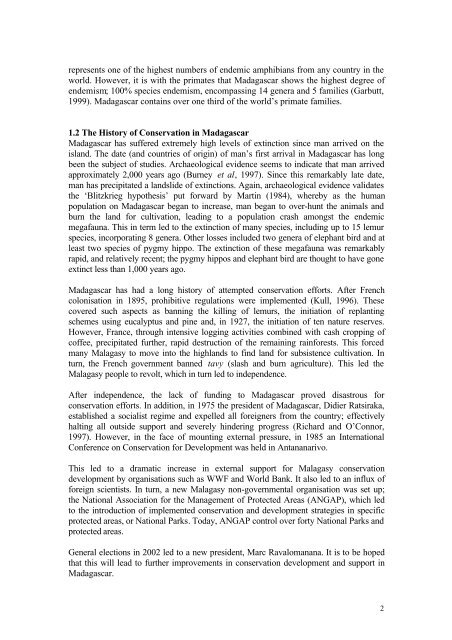The proposed Parc Regional de Belomotse - Frontier-publications ...
The proposed Parc Regional de Belomotse - Frontier-publications ...
The proposed Parc Regional de Belomotse - Frontier-publications ...
You also want an ePaper? Increase the reach of your titles
YUMPU automatically turns print PDFs into web optimized ePapers that Google loves.
epresents one of the highest numbers of en<strong>de</strong>mic amphibians from any country in the<br />
world. However, it is with the primates that Madagascar shows the highest <strong>de</strong>gree of<br />
en<strong>de</strong>mism; 100% species en<strong>de</strong>mism, encompassing 14 genera and 5 families (Garbutt,<br />
1999). Madagascar contains over one third of the world’s primate families.<br />
1.2 <strong>The</strong> History of Conservation in Madagascar<br />
Madagascar has suffered extremely high levels of extinction since man arrived on the<br />
island. <strong>The</strong> date (and countries of origin) of man’s first arrival in Madagascar has long<br />
been the subject of studies. Archaeological evi<strong>de</strong>nce seems to indicate that man arrived<br />
approximately 2,000 years ago (Burney et al, 1997). Since this remarkably late date,<br />
man has precipitated a landsli<strong>de</strong> of extinctions. Again, archaeological evi<strong>de</strong>nce validates<br />
the ‘Blitzkrieg hypothesis’ put forward by Martin (1984), whereby as the human<br />
population on Madagascar began to increase, man began to over-hunt the animals and<br />
burn the land for cultivation, leading to a population crash amongst the en<strong>de</strong>mic<br />
megafauna. This in term led to the extinction of many species, including up to 15 lemur<br />
species, incorporating 8 genera. Other losses inclu<strong>de</strong>d two genera of elephant bird and at<br />
least two species of pygmy hippo. <strong>The</strong> extinction of these megafauna was remarkably<br />
rapid, and relatively recent; the pygmy hippos and elephant bird are thought to have gone<br />
extinct less than 1,000 years ago.<br />
Madagascar has had a long history of attempted conservation efforts. After French<br />
colonisation in 1895, prohibitive regulations were implemented (Kull, 1996). <strong>The</strong>se<br />
covered such aspects as banning the killing of lemurs, the initiation of replanting<br />
schemes using eucalyptus and pine and, in 1927, the initiation of ten nature reserves.<br />
However, France, through intensive logging activities combined with cash cropping of<br />
coffee, precipitated further, rapid <strong>de</strong>struction of the remaining rainforests. This forced<br />
many Malagasy to move into the highlands to find land for subsistence cultivation. In<br />
turn, the French government banned tavy (slash and burn agriculture). This led the<br />
Malagasy people to revolt, which in turn led to in<strong>de</strong>pen<strong>de</strong>nce.<br />
After in<strong>de</strong>pen<strong>de</strong>nce, the lack of funding to Madagascar proved disastrous for<br />
conservation efforts. In addition, in 1975 the presi<strong>de</strong>nt of Madagascar, Didier Ratsiraka,<br />
established a socialist regime and expelled all foreigners from the country; effectively<br />
halting all outsi<strong>de</strong> support and severely hin<strong>de</strong>ring progress (Richard and O’Connor,<br />
1997). However, in the face of mounting external pressure, in 1985 an International<br />
Conference on Conservation for Development was held in Antananarivo.<br />
This led to a dramatic increase in external support for Malagasy conservation<br />
<strong>de</strong>velopment by organisations such as WWF and World Bank. It also led to an influx of<br />
foreign scientists. In turn, a new Malagasy non-governmental organisation was set up;<br />
the National Association for the Management of Protected Areas (ANGAP), which led<br />
to the introduction of implemented conservation and <strong>de</strong>velopment strategies in specific<br />
protected areas, or National Parks. Today, ANGAP control over forty National Parks and<br />
protected areas.<br />
General elections in 2002 led to a new presi<strong>de</strong>nt, Marc Ravalomanana. It is to be hoped<br />
that this will lead to further improvements in conservation <strong>de</strong>velopment and support in<br />
Madagascar.<br />
2
















